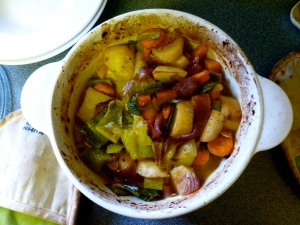 If you’ve ever seen the Gavin and Stacey Christmas special where Mick worries about debuting a new turkey recipe for the family dinner, then you’ll understand what I mean when I say that I felt a similar anxiety placing this dish in the oven. Much like Mick, once the tagine had begun to cook, I found that a lot of people had had difficulties with the recipe, particularly regarding the quantities of ingredients for the paste that not only flavours the vegetables, but gives the dish its sauce.
If you’ve ever seen the Gavin and Stacey Christmas special where Mick worries about debuting a new turkey recipe for the family dinner, then you’ll understand what I mean when I say that I felt a similar anxiety placing this dish in the oven. Much like Mick, once the tagine had begun to cook, I found that a lot of people had had difficulties with the recipe, particularly regarding the quantities of ingredients for the paste that not only flavours the vegetables, but gives the dish its sauce.
Chemoula paste varies from recipe to recipe – whilst the ingredients used and ratios of such ingredients are only subtly different, the effect of these changes shape the dish in entirely different ways. The problem noted with this recipe was the quantity of lemon juice – lots of people said it was overpowering in the dish, and gave it an unpleasantly bitter, acidic taste. In this particular recipe, the lemon juice seemed to be a counter to the honey, each used to offset the sweetness and acidity of the other, to create a balanced taste. Luckily, fate had taken this into account, and I was forced to reduce the quantity of lemon juice as I only had a tiny amount left in the cupboard – I did not find my chermoula paste to have a strong acidity, but equally it was not so minimal an amount that it became too sweet with the quantity of honey.
Further, there were many comments regarding the overall flavour of the dish – people complained that despite the wide variety of spices and vegetables, the dish as a whole was tasteless and bland. This can occur because although there is an array of individual flavours, each has not had sufficient time to blend together and create a wholesome taste. This is easily solved by making the dish in advance. Much like spaghetti bolognese, or chili con carne, when people clamour “it’s much better the next day!”, it’s because the flavours have had time to cook twice – in cooking originally, cooling down, then having another chance to blend when reheated the next day. Using this philosophy, making the chermoula paste a day in advance, or even making the whole dish a day in advance and reheating would increase the overall taste. However, be cautious with making the whole dish and reheating, as the vegetables could become mushy during a second cooking process, or equally possible, the sauce could evapourate leaving the dish dry! I would advise making the chermoula paste a day in advance, and leaving it to marinate the vegetables overnight before cooking for the most intense flavour.
Ingredients
- 2 red onion, thickly sliced
- 2 garlic cloves, peeled but left whole
- ½ tbsp. honey
- ½ tbsp. turmeric
- ½ tbsp. paprika
- 30ml lemon juice
- 50ml olive oil
- 1 tsp. dried chili flakes
- 2 tsps. dried ginger
- 2 carrots, cut into 2cm chunks
- 1 parsnip, chopped into thick chunks
- 2 leeks, sliced thickly
- 1 large potato, cut roughly
- Dried mint
- Salt and pepper
- Olive oil, to drizzle
Method
- Begin by making the paste that the vegetables will absorb during the cooking process. Using a blender, blitz one of the onions, the garlic cloves, honey, lemon juice and oil alongside the turmeric, paprika and chili flakes.
- Blend until it is largely smooth, and then decant into a small bowl. Set aside this paste for later. In a heat-proof casserole dish or large frying pan, warm a drizzle of olive oil over a medium heat.
- Heat the oven to 180 degrees.
- Add the potatoes, parsnips and carrots, sprinkle with the ground ginger, and fry until lightly browned, stirring to prevent them burning.
- Once these have browned, transfer them into a tagine or a large casserole dish. Then fry the leeks and remaining onion with a dusting of ginger in the heat-proof casserole dish until also lightly browned, then place in the casserole dish/tagine alongside the potato mix.
- Pour the paste over the lightly browned vegetables, and then add 500ml of warm water. Put a lid on top of the casserole dish/tagine, and place in the oven for 30 minutes.
- After 30 minutes, turn the oven down to 160 degrees, and remove the casserole dish/tagine from the oven. Season, and replace in the oven without the lid for a further 30 minutes.
- Remove the tagine from the oven, top with mint and serve with either cous-cous or rice.

